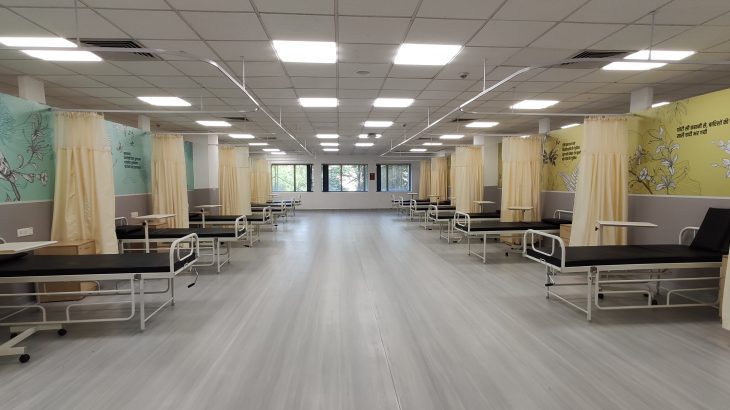The current outbreak of SARS-CoV-2 has and continues to put huge pressure on intensive care units (ICUs) worldwide. There is a serious need to augment the capacity of the public health care system to deliver care. It is in this climate of emergency that Wipro Ltd and Venkataramanan Associates joined hands to refurbish an existing office facility into a 450-bed COVID-19 Care hospital in Hinjewadi, Pune.
This hospital is designed to meet best-practice standards prescribed by the Containment Plan of the Government of India and WHO. The existing workspace was re-purposed to accommodate Isolation Beds, reception, testing lab, kitchen, and staff center. Although the site itself is verdant with an advantage of vast seclusion to promote wellbeing, converting a non-healthcare building to patient care comes with its own set of challenges. A flexible, fast-assembled, adaptable structure was to be designed in a record timeline of 15 days and executed within the next 15 amid a nationwide lockdown.
Focused on segregating patient and healthcare staff movement, the floor plans reduce cross-contamination by design. A team of medical experts advised and guided the design to meet best-practices in COVID-19 care in the thick of constantly changing protocols. The retrofit design sustained elements of the existing fit-out to reduce execution time and ensure funds were utilized towards better patient care equipment. False ceiling, walls, partitions of meeting rooms, flooring in certain areas were retained as-is. The existing Air conditioning system was modified and converted to a 100% once-through system for COVID-19 wards. The fresh air intake was treated with UV radiation and pressure differentials were maintained between the ward and staff zones. Further, Natural & forced exhaust was provided to create a decentralized system.
Besides the sound functionality, the hospital design aims to provide a requiem for its patients and healthcare workers. The journey of the user is interspersed with uplifting graphics, textures, and colours. Fear and anxiety associated with clinical settings can exacerbate healthcare issues. Incorporating art humanizes the experience; the graphics incorporated in this hospital derive inspiration from nature and is expressed in Pastel tone to connote healing and compassion. Combining Marathi and English in the graphics and signages ensures inclusivity, while specially-curated music provides a welcoming, holistic, and positive environment.
Today the hospital operates at full capacity. The success of this facility can be traced to its low infection fatality rate of 0.5% compared to a national average of 1.6% and a global average of 2.97%. Besides, the design itself is modular and can be replicated and adapted to fit another context. This re-purposed IT campus is India’s first public-private partnership Hospital for COVID-19 and set the standard for all such facilities in the state and nation to follow.
